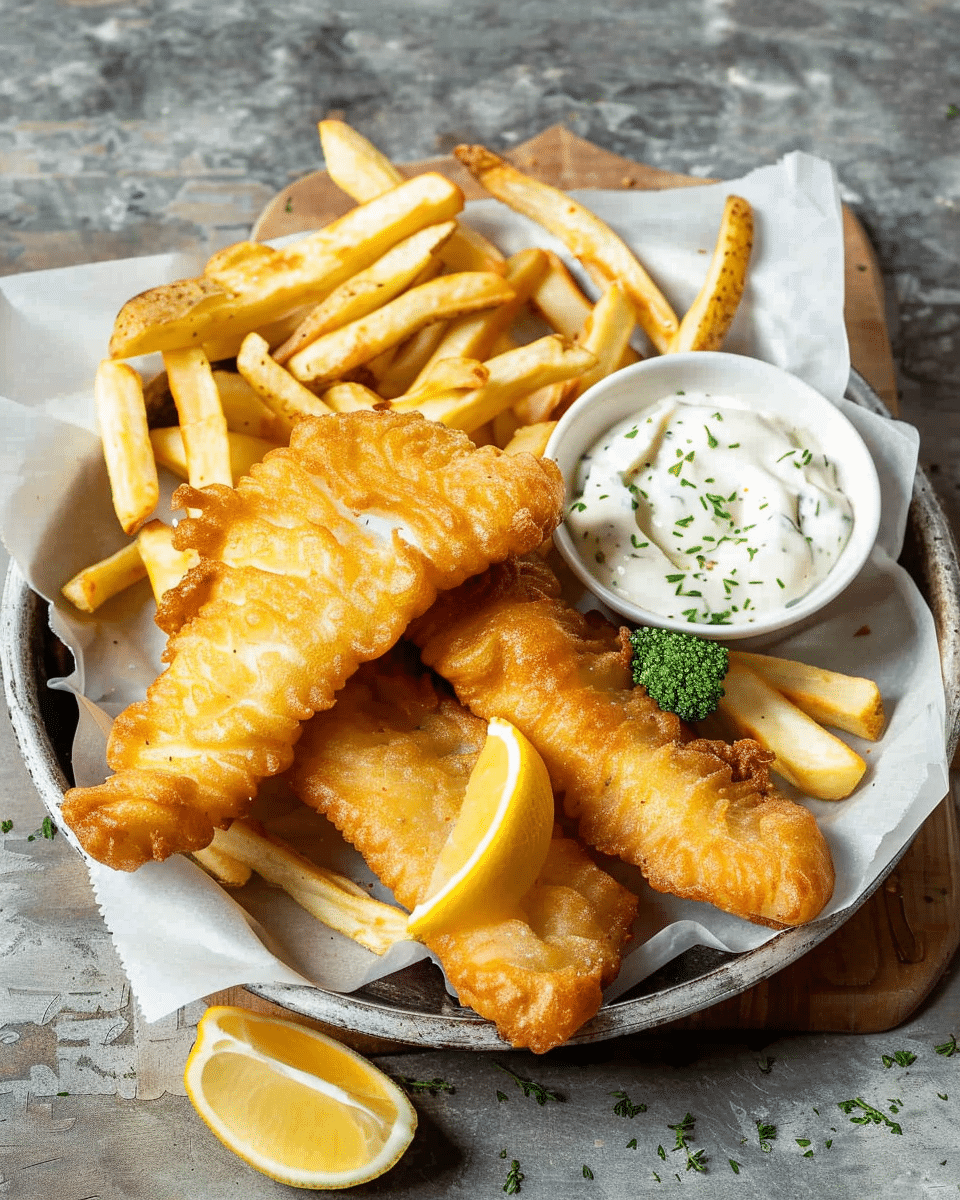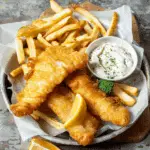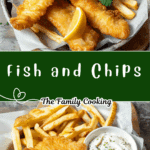Why You’ll Love This Recipe
Fish and chips is the ultimate indulgence with its crispy batter, tender fish, and soft, fluffy chips. The contrast between the crunchy coating and the tender fish inside creates the perfect bite. The versatility of the dish also makes it great for customization—add your favorite sauces, like tartar sauce, malt vinegar, or even a spicy ketchup for an extra punch. Whether you’re enjoying it at home or recreating a pub-style meal, this dish is sure to please with its classic, comforting flavors.
Ingredients
For the fish:
-
4 white fish fillets (cod, haddock, or pollock are ideal)
-
1 cup all-purpose flour (for dredging)
-
Salt and pepper, to taste
For the batter:
-
1 cup all-purpose flour
-
1 teaspoon baking powder
-
1/2 teaspoon salt
-
1 teaspoon paprika (optional for extra flavor)
-
1 cup cold sparkling water (or cold beer for an extra crisp batter)
For the chips:
-
4 large russet potatoes, peeled and cut into thick fries
-
Vegetable oil, for frying
-
Salt, to taste
For serving:
-
Lemon wedges
-
Tartar sauce (optional)
-
Malt vinegar (optional)
(Tip: You’ll find the full list of ingredients and measurements in the recipe card below.)
Directions
1. Prepare the chips:
-
Heat vegetable oil in a large pot or deep fryer to 350°F (175°C). You’ll need enough oil to fully submerge the chips.
-
While the oil is heating, peel the potatoes and cut them into thick fries. Rinse the fries in cold water to remove excess starch, then pat them dry with a paper towel.
-
Fry the potatoes in batches for about 3-4 minutes until they are soft but not yet golden. Remove from the oil and drain on paper towels. This step helps create crispy fries when fried a second time.
-
Increase the oil temperature to 375°F (190°C). Fry the chips again in batches for about 4-5 minutes, or until golden brown and crispy. Remove and drain on paper towels. Season with salt immediately.
2. Prepare the fish:
-
Pat the fish fillets dry with paper towels and season with salt and pepper on both sides.
-
Lightly dredge the fish fillets in flour, shaking off any excess. This step helps the batter stick to the fish.
3. Make the batter:
-
In a mixing bowl, whisk together the flour, baking powder, salt, and paprika (if using). Gradually add the cold sparkling water (or beer) and whisk until the batter is smooth and thick but still able to coat the fish.
-
The batter should be thick enough to stick to the fish without running off. If it’s too thin, add a little more flour.
4. Fry the fish:
-
Heat the oil in the deep fryer or large pot to 375°F (190°C).
-
Dip the flour-coated fish fillets into the batter, making sure they are fully coated.
-
Carefully lower the battered fish into the hot oil and fry for 5-6 minutes, or until the batter is golden and crispy and the fish is cooked through. The fish should flake easily with a fork.
-
Remove the fish from the oil and drain on paper towels.
5. Serve:
-
Serve the fish and chips hot with lemon wedges on the side for squeezing over the fish. You can also serve it with tartar sauce, malt vinegar, or peas for an authentic British experience.
-
Enjoy immediately while the fish is crispy and the chips are hot and fluffy!
Servings and Timing
Servings: 4
Total time: 45 minutes
Variations
-
Spicy Fish and Chips: Add cayenne pepper, chili powder, or ground black pepper to the batter for a spicy kick.
-
Beer Batter Fish and Chips: Use cold beer instead of sparkling water for a richer, deeper flavor in the batter.
-
Sweet Potato Chips: Substitute regular potatoes with sweet potatoes for a sweeter, healthier variation.
-
Vegetarian Fish and Chips: For a meat-free version, substitute the fish with a plant-based fillet, such as battered cauliflower or a soy-based alternative.
Storage/Reheating
Storage: While fish and chips are best enjoyed fresh, you can store the leftovers in an airtight container in the refrigerator for up to 1 day.
Reheating: To keep the batter crispy when reheating, place the fish and chips on a baking sheet and reheat them in a preheated oven at 375°F (190°C) for 8-10 minutes until crispy. Avoid using the microwave, as it can make the batter soggy.
FAQs
1. Can I use frozen fish for Fish and Chips?
Yes, you can use frozen fish fillets, but be sure to thaw them completely before frying. Fresh fish is typically recommended for the best flavor and texture.
2. Why is my batter not sticking to the fish?
Ensure the fish is dry before dipping it into the batter and flour mixture. If the fish is too wet, the batter may slide off. Also, make sure the oil is hot enough when frying, as it helps the batter stay crisp and adhere to the fish.
3. Can I make Fish and Chips without deep frying?
Yes, you can bake the fish and chips instead of deep frying. To bake the fish, coat it in the batter, place it on a baking sheet lined with parchment paper, and bake at 400°F (200°C) for about 12-15 minutes or until golden and crispy. For the chips, toss them in a little oil and bake at 425°F (220°C) for 25-30 minutes, flipping halfway through.
4. What type of fish is best for Fish and Chips?
Traditionally, white fish like cod, haddock, or pollock is used for Fish and Chips. These fish have a mild flavor and a firm texture that holds up well to frying.
5. How do I make the chips crispy?
For crispy chips, it’s important to fry them twice—first at a lower temperature to cook them through, then at a higher temperature to crisp them up. Be sure to season them with salt immediately after frying to enhance the flavor.
6. Can I make the batter ahead of time?
It’s best to use the batter immediately after mixing it to achieve the crispiest texture. However, you can prepare the dry ingredients ahead of time and mix them with the wet ingredients just before frying.
7. Can I make a gluten-free version of Fish and Chips?
Yes, you can substitute the all-purpose flour with a gluten-free flour blend for the batter and dredging. Be sure to check that the breadcrumbs are gluten-free as well.
8. What can I serve with Fish and Chips?
Traditional sides include tartar sauce, mushy peas, or a simple green salad. You can also serve Fish and Chips with a side of pickled onions or coleslaw for added flavor.
9. How can I keep the fish crispy after frying?
To keep the fish crispy, place it on a wire rack over a baking sheet rather than on paper towels. This allows air to circulate around the fish and helps maintain the crispiness.
10. Can I make Fish and Chips in advance?
Fish and chips are best served immediately after cooking, as the batter may lose its crispiness over time. However, you can prepare the chips in advance and fry them when you’re ready to serve. Keep the fish warm in a low oven (about 200°F or 90°C) while you fry the chips.
Conclusion
Fish and Chips are the quintessential comfort food—crispy, satisfying, and full of flavor. Whether you’re making this British classic for a casual dinner or a special occasion, it’s sure to be a hit. The golden, crispy fish, perfectly fried chips, and tangy tartar sauce make for a delicious combination that’s hard to resist. With this recipe, you’ll be able to enjoy the taste of traditional Fish and Chips in the comfort of your own home.
Fish and Chips
5 Stars 4 Stars 3 Stars 2 Stars 1 Star
No reviews
Fish and Chips is a beloved British classic consisting of golden, crispy fried fish fillets paired with fluffy, perfectly cooked chips. Served with tartar sauce or malt vinegar, this dish is comforting, satisfying, and perfect for a casual meal.
- Author: Laura
- Prep Time: 15 minutes
- Cook Time: 30 minutes
- Total Time: 45 minutes
- Yield: 4 servings
- Category: Main Course
- Method: Frying
- Cuisine: British
Ingredients
- 4 white fish fillets (cod, haddock, or pollock)
1 cup all-purpose flour (for dredging)
Salt and pepper, to taste
For the batter:
1 cup all-purpose flour
1 teaspoon baking powder
1/2 teaspoon salt
1 teaspoon paprika (optional for extra flavor)
1 cup cold sparkling water (or cold beer for an extra crisp batter)
For the chips:
4 large russet potatoes, peeled and cut into thick fries
Vegetable oil, for frying
Salt, to taste
For serving:
Lemon wedges
Tartar sauce (optional)
Malt vinegar (optional)
Instructions
Prepare the chips: Heat vegetable oil in a large pot or deep fryer to 350°F (175°C). Peel the potatoes and cut them into thick fries. Rinse in cold water, then pat dry. Fry the fries in batches for 3-4 minutes, then drain. Increase the oil temperature to 375°F (190°C) and fry for another 4-5 minutes until golden brown and crispy. Season with salt immediately after frying.
- Prepare the fish: Pat the fish fillets dry with paper towels and season with salt and pepper. Lightly dredge each fillet in flour.
- Make the batter: In a bowl, whisk together flour, baking powder, salt, and paprika. Gradually add cold sparkling water (or beer), whisking until smooth and thick. The batter should coat the fish without running off.
- Fry the fish: Heat oil to 375°F (190°C). Dip the flour-coated fish fillets into the batter, ensuring they’re fully coated. Fry for 5-6 minutes until the batter is golden and crispy. Remove the fish and drain on paper towels.
- Serve: Serve the fish and chips with lemon wedges, tartar sauce, or malt vinegar. Enjoy while the fish is crispy and the chips are hot and fluffy!
Notes
- For extra flavor, use beer instead of sparkling water in the batter.
- Sweet potato chips make for a healthier variation.
- If you prefer to bake instead of deep frying, bake the battered fish at 400°F (200°C) for 12-15 minutes and the chips at 425°F (220°C) for 25-30 minutes.
Nutrition
- Serving Size: 1 serving
- Calories: 600
- Sugar: 2g
- Sodium: 950mg
- Fat: 30g
- Saturated Fat: 4g
- Unsaturated Fat: 22g
- Trans Fat: 0g
- Carbohydrates: 65g
- Fiber: 6g
- Protein: 30g
- Cholesterol: 50mg



